Yangon
Yangon is the main gateway to Myanmar with lush tropical trees, shady parks and beautiful lakes. The city of Yangon is attractive in its own special way. Not a modern neon light city, but a town where you can see the glittering Shwedagon Pagoda, attractive colonial architecture of old "Rangoon", the serene Sule Pagoda, the sprawling Bogyoke Aung San Market and Theingyi Zei, the peaceful Kandawgy and Inya Lake.
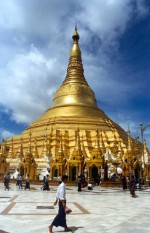
Shwedagon Pagoda
The Shwedagon Pagoda is the main attraction. It is estimated that it has been built approximately 2,500 years ago. It is venerated for the embodiment of relics of Buddhas. Its oldest stupa built between VI and X century rises 98 meters (326 feet) above its base. The Pagoda was renovated many times over the centuries by various Myanmar Kings. It is not just one main stupa but a complex of many stupas, temples, shrines, prayer halls, religious images and statues. The staircases up to the stupa are lined with stalls selling religious articles, silver ware, souvenirs, lacquer wares, handicrafts, flowers, ceremonial umbrellas etc.
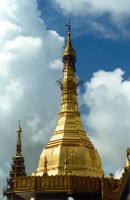
Sule Pagoda
The Sule Pagoda is situated in the center of Yangon near Mahabandoola Park, Independence Monument and City Hall. It is said that the Sule Pagoda is over 2000 years old and enshrines a hair of Buddha. Small shops surround the 46 meters high pagoda.
Chauk Htat Gyi Reclining Buddha Statue
Located on the Shwegondaing Road the 70 meters long reclining Buddha is one of the largest in Myanmar. The original image was built in 1907. In 1957 it was demolished and rebuilt to this structure in 1966.
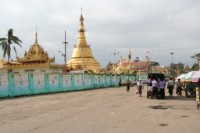
Botataung Pagoda
Standing on the river-bank , you will enjoy from there the most scenic point of view on marine-life of the Yangon river. The name of the paya refers to the 1000 military leaders who escorted the relics of Buddha coming from India 2000 years ago. The centre of attention is the original hair-relics, which can be viewed in a glass-sealed relic-chamber.
National Museum
The most relevant object in this museum is the “Lion Throne”, once the symbol of power and authority of King Thibaw Min, the last king of Myanmar.
Thanlyin (Kyauk Tan)
Across the river lies Thanlyin, which was the base for Philip De Brito, a Portuguese adventurer, in the early 17 century. The place hosts an old church with nothing left but only a shell and tomb-stone with inscriptions. Out of town lies Kyaik-khaukPaya which contains two Buddhas’hairs and two tombs of famous Burmese writers. About 12 km further are to see the Yele Paya (also called Mid River Pagoda) and a gigantic sitting Buddha at Padagyi village.
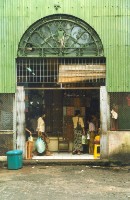
Bogyoke Aung San Market
The Bogyoke Market (Scott Market) is the "Shopping Center" of Yangon. It was first built in 1936 and named Scott Market after Mr. C. Scott, the Municipal Commissioner. Nowadays, the name was changed to the national leader General Aung San who was assassinated in 1947. There are around 2.000 shops selling luxury items, handicrafts, foodstuffs, clothing, jewellery, fashion and other consumer goods.
The market is open daily from 8.00 AM to 6.00 PM except Mondays and puplic holidays.
The best time to visit is between 8.00 AM and 10.00 AM, when the entire market is open.
Bago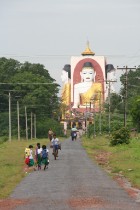
Bago (Pegu) is situated 80 km from Yangon. It is about a 2 hours drive from Yangon. Bago was the ancient capital of the Mon Kingdom (15 century). There are many tourist attractions like Shwet Tha Lyaung Buddha Image, Shwemawdaw Pagoda, Kyaikpun Pagoda etc.
Shwemawdaw Pagoda
The Paya is the heart of the region and is widely known as Payagyi (Great Golden God Paya, 114m high). Like the phoenix in Greek mythology, the Paya has suffered and been recovered from 34 severe earth-quakes during its history, as Bago lies on the epicentre in the earth-quake prone-zone. Unlike the elegant Shwedagon, there is an out-break between the octagonal base and the bell-edge of the upper-structure. In fact, it is higher than any other pagoda in Myanmar.
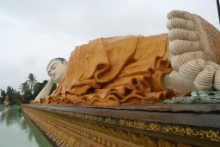
Shwe Tha Lyaung Buddha Image
This reclining Buddha measures 55 m long, 16 m high and 9 m wide. It was first built centuries ago (994 AD) and was totally lost after the destruction of Bago in 1757. Its restoration took place from 1881 to 1903. The Buddha Image is built in a well proportionate structure and symmetrical balance, so it looks quite realistic. Behind the Buddha figure you will see wall paintings and bas-relief carvings relating the historical foundation of the image.
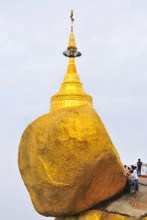
Kyaikhtiyo (Golden Rock)
The Kyaikhtiyo Pagaoda is also known as the Golden Rock. It is the largest domestic tourism centre located about 140 km east (5 hours drive) from Yangon. The Golden Rock is a sacred, massive, gold-leafed boulder resting precariously on the edge of a cliff at the top of Mount Kyaik Hti Yoe. The hill lies about 1100 m above the sea level. The legend says that the balance of the rock is due to a Buddha’s hair specially placed in the stupa.
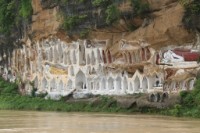
Pyay
Pyay (Prome or Pyi) is best known for the nearby archaelogical site of Sri Ksetra (3rd to 4th century AD) known as Thaye Khittaya today. It is an important trading centre between Lower and Upper Myanmar. Pyay in Myanmar language means nation or country. It is located on the river bank of the Ayeyarwaddy river, 7 hours North from Yangon. According to legend Myanmar starts from this city. There is one railway line from Yangon to Pyay, which is the very first railway line in Myanmar built by the British .
About 34 miles to the south-west of Pyay there is a beautiful spot, called Ah Kauck Taung. Along the river there are many Buddha Images of various size placed in niches in the face of rock. It is possible to climb up to visit the area on the cliff.
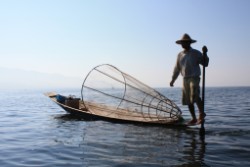
Inle Lake
At 875 metres above sea level, Inle Lake is surrounded by high hills which keep the lake area misty. 22 km long and 11 km wide, Inle Lake is the home of 70.000 Bamar, Danaw, Danu, Intha, Kayah, Pa-O, Shan, and Taung-yo peoples, among others - roughly half of the area’s population. The water is covered with floating gardens and busy fishing canoes.
One of the two natural big lakes in Myanmar, Inle is situated on the Nyaung Shwe plain in Southern Shan State. It is an uphill lake and the commonest tour destination in Eastern Shan plateau. The leg-rowing style of the inhabitants is so stylistic and breathtaking. Then, the colourful ethnical tribes at market place, the traditional costumes at pagoda festivals and the ceremonies always reveal the incredible beauty of this lake.
Two famous highlights are the Paungdawoo pagoda festival, which lasts three weeks between September and October, and the traditional regatta contest. Handicrafts of Shan clothes, bags, and silver-wares will be on your souvenir shopping list.
Kalaw
Kalaw is a peaceful and quiet place situated in the West of the Shan State. Being a former British colonial hill station, this small-town offers cool temperatures (Kalaw sits at 1.300 meters elevation) and plenty of trekking opportunities. If you are traveling by car, it's about two hours west of Nyaungshwe on the western edge of the Shan hills.
Trekking around Kalaw can vary from a one-day to a three-day trek into the surrounding hills.
Palaung women wear colourful blue and red costumes and families often live in "long houses".
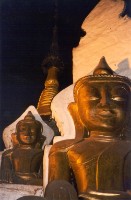
Pindaya
Pindaya is about 45 km north of Kalaw. The small and quiet town is a picturesque place and famous for its caves in which more than 8.000 Buddha Images, which have been put there over the centuries. The images are of various sizes, some carved in the face of rock and some deposited in niches in walls.
Pindaya City not only popular for its caves but also for its scenic road passing through Pa-O and Danu villages surrounded with fields of potatoes which are grown in red mud mounds.
Kakku
Kakku is located on the borderline of Shan and Pa-O region and is managed by a Pa-O collective. The land route from Inle Lake (Nyaung Shwe) to Kakku is 144 km (3 hours drive), and most of the road is well paved and tarred. There is a railway line between Taungyi and Kakku. It has been constructed by the government in 1996, but foreigners aren’t allowed to take public transport to the site.
Over two thousand Stupas, not higher than 3m to 4m, in various shapes and descriptions, are spread within Kakku Pagoda Complex and are the main attraction of the place.
The beautiful landscape surrounding the pagodas and the small winding roads leading to the complex, permitting close observation of the vegetation and cultivation practices, is also of great interest. The final attraction is the observation of the daily life of the Pa-o tribal, their culture and their villages lining up along the main road.
Bagan
Bagan is the most extraordinary sight in Myanmar dotted with thousand of 800-year old Pagodas and Temples spread all over the place stretching along the Ayeyarwady River. Some of them with beautiful mural paintings.
The archaeological zone is situated in Old Bagan which sits on the eastern bank of a deep bend of the Irrawaddy River. This zone, where are situated the villages of Myinkaba, Bagan Myothit and Thiripyitsaya, is known as Bagan.
The most famous places are the Ananda Temple, That byin nyu Temple, Swegugyi Temple, Guibyaukgyi Temple, Htilo Minlo Temple, Swezigon Pagoda and Bupaya Pagoda.
Shopping: The pride of Bagan are the masterpieces of laquerware since the days of the Bagan Empire. Today you can see the process of making lacquerwares from the basic stage to the finished products. There are many shops to buy lacquerware such as bowls, plates, boxes etc.
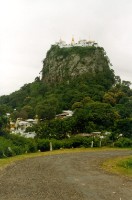
Mount Popa
Mount Popa is a volcanic cone rising to 737 m. (1518 from the sea level). At the top is the Popa Taungkalat, famously confused with Mt Popa itself. The Popa Taungkalat is the favoured home of the 37 Burmese nats (animist spirit entities). Popa is the center of the most important nat worship in Myanmar.
The hole Top is dotted with pagodas and shrines which are made accessible by stairways.
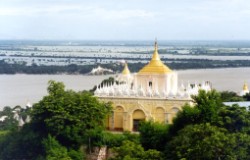
Mandalay
Mandalay is situated 600 km North of Yangon and was named after the Mandalay Hill, which is situated at the northeast corner of the present city. It is the historical old capital of Myanmar , interesting for culture and traditional arts and crafts. It is also here that the Fifth Buddhist synod took place under the reign of King Mindon. Mandalay was the capital of the last Burmese kingdom, which in was finally conquered by British colonial forces in 1886. Mandalay still has considerable cultural and religious significance and its Buddhist monasteries are among the most important in the country. About 60% of all the monks in Myanmar reside in the Mandalay area.
The four ancient cities around and near Mandalay:
Amarapura, with the U Bein's wooden bridge which is made out of teak and is 1.2 km long and the Mahagandhayong Kyaung, center for monastic study for several thousand young monks.
Inwa (Ava) is an ancient city and was the former capital of a Burmese kingdom between 1364 and 1841. A perfect place to go around by a horse cart.
Sagaing, was the capital of the independent Shan kingdom from 1315 to 1364, and later again from 1760 to 1764. Today it is a place mostly known as a religious centre with dozen of Buddhist monasteries and nunneries. In the Sagaing area there are some 600 Buddhist pagodas, temples and monasteries.
Mingun, is a pleasant and interesting trip with plenty to see along the way.
Around Mandalay
Pyin Oo Lwin (renamed Maymyo by a British colonel) lies 67 km east from Madalay, at 1070 m. There are several natural attractions around Pyin Oo Lwin and many colonial–aera buildings. It enjoys cool and pleasant weather the hole year round.
Monywa
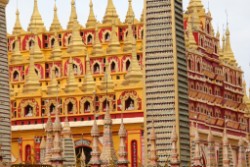
About 136 km to the west of Mandalay is Monywa, the commercial city of Chin-Dwin Valley.
Places of interest:
Thanbokde Pagoda with more than 500 000 Buddha Images
Bodhi Tataung Pagode with a reclining Buddha (90 m long) and a standing Buddha (100 m high) and around 1.000 Buddha Statues with umbrellas
Leidi Kyaung Teik Monastry
Hpo Win Taung Caves
Kyaw Naing, Licensed Tour Guide
For more details and other destinations in Myanmar, please kindly contact me by e-mail or contact form.
e-mail: kn-ygn@myanmar.com.mm
e-mail: kyawnaing.yangon@gmail.com
e-mail: kyawnaing.yangon@yatanarpon.com.mm